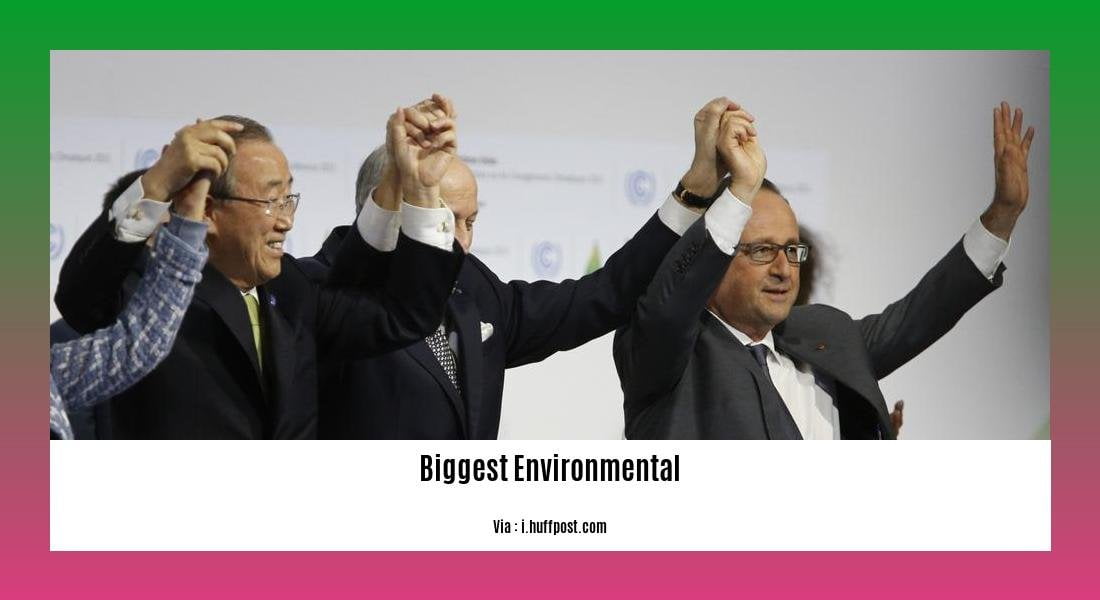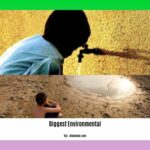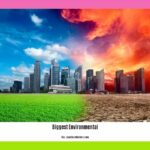Uncovering the Biggest Environmental Issues: From Climate Change to Endangered Species
As the world grapples with the ever-increasing urgency of protecting our environment, it becomes crucial to shed light on the biggest environmental issues plaguing our planet. From the existential threat of climate change to the alarming loss of biodiversity and the devastating impacts of pollution, our world is facing unprecedented challenges. In this article, we will delve into these pressing environmental problems, exploring their far-reaching consequences and the need for immediate action. Through understanding and awareness, we can work together towards a sustainable future for generations to come.
Key Takeaways:
-
Climate Change: Human activities, such as burning fossil fuels and deforestation, are causing climate change, resulting in rising temperatures, extreme weather events, and sea-level rise.
-
Loss of Biodiversity: Factors like habitat destruction, pollution, overexploitation, and climate change contribute to the rapid loss of species and ecosystems, threatening global biodiversity and disrupting ecological balance.
-
Deforestation: Clearing forests for agriculture, mining, and urbanization leads to habitat destruction, loss of carbon sinks, and disruption of ecosystems on local and global levels.
-
Water Scarcity: The increasing global demand for water, coupled with pollution and inadequate management, results in water scarcity, impacting agriculture, human health, and ecosystems.
-
Pollution: Air, water, and soil pollution from various sources, such as industrial activities, transportation emissions, and improper waste disposal, have harmful effects on both human health and the environment.
-
Resource Depletion: Overconsumption of natural resources, including minerals, fossil fuels, and freshwater, leads to depletion and environmental degradation, necessitating sustainable resource management and transitioning to renewables.
-
Plastic Pollution: Excessive use and improper disposal of plastic products have caused a global crisis of plastic pollution in oceans, landfills, and food chains, emphasizing the need for reduction, recycling, and sustainable alternatives.
-
Ozone Depletion: Harmful chemicals like chlorofluorocarbons (CFCs) contribute to the depletion of the ozone layer, increasing UV radiation exposure and posing risks to human health and ecosystems.
-
Soil Degradation: Unsustainable agricultural practices, deforestation, and urbanization contribute to soil degradation and erosion, impacting food production, biodiversity, and the possibility of desertification.
-
Overpopulation: The increasing global population exerts additional pressure on natural resources, ecosystems, and the environment, highlighting the need for sustainable solutions and efficient resource management.
For more detailed information and analysis on these environmental issues, you can refer to the United Nations Environment Programme (UNEP) at and National Geographic at
Biggest Environmental Issues
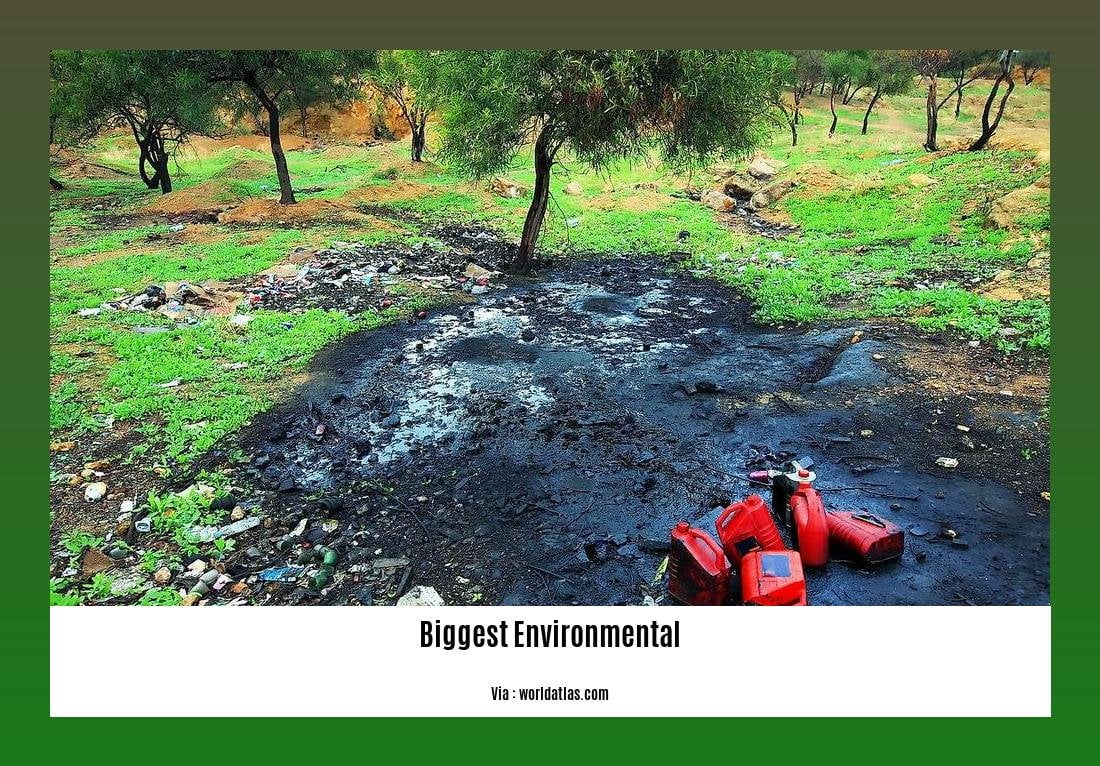
As we navigate the challenges of the 21st century, it’s essential to understand and tackle the biggest environmental issues facing our planet. From climate change to endangered species, our actions today have far-reaching consequences for the future of our planet and all its inhabitants. In this article, we will delve deep into these pressing concerns and shed light on their causes, consequences, and potential solutions. So, let’s embark on this exploration of the biggest environmental issues that demand our immediate attention.
1. Climate Change: The Urgency of Reducing our Carbon Footprint
Climate change sits at the forefront of the biggest environmental issues humanity has ever faced. The burning of fossil fuels, deforestation, and other human activities have led to a significant increase in greenhouse gas emissions, trapping heat in the atmosphere and causing global temperatures to rise. The consequences of climate change are already apparent – from more frequent and severe weather events to rising sea levels and disrupted ecosystems. The urgency to reduce our carbon footprint and transition towards renewable energy sources is more crucial now than ever.
2. Loss of Biodiversity: Protecting the Web of Life
The rapid loss of biodiversity poses a significant threat to our planet’s delicate balance. Factors such as habitat destruction, pollution, overexploitation, and climate change contribute to the decline in species and ecosystems. Every organism, no matter how small, plays a vital role in maintaining the web of life. The loss of biodiversity not only disrupts ecosystem functions but also affects human well-being. To address this issue, we need to protect and restore habitats, implement sustainable practices, and promote conservation efforts on a global scale.
3. Deforestation: Preserving our Lungs
Forests are often referred to as the lungs of the Earth, as they absorb carbon dioxide and release oxygen, playing a crucial role in mitigating climate change. However, deforestation rates have been alarming, largely driven by the expansion of agriculture, mining, and urbanization. This destruction of forests has severe environmental impacts, including habitat loss, the release of stored carbon, and disruption of ecosystems. To combat deforestation, we must prioritize sustainable land use, promote reforestation efforts, and support initiatives that protect our forests and the biodiversity they harbor.
4. Water Scarcity: Nurturing our Lifeline
Water scarcity has become a growing concern worldwide, affecting both human populations and ecosystems. The increasing global demand for water, coupled with pollution and inadequate management, has led to water shortages in many regions. This issue poses significant challenges for agriculture, human health, and the environment. To ensure water security for all, we must prioritize sustainable water management, educate communities on conservation practices, and invest in efficient water infrastructure.
5. Pollution: A Threat to Health and the Environment
Different forms of pollution, such as air, water, and soil pollution, pose a substantial risk to human health and the environment. Industrial activities, transportation emissions, and improper waste disposal contribute to the release of harmful pollutants into our ecosystems. This pollution not only impacts the quality of our air, water, and soil but also puts the health of both humans and wildlife at risk. To combat pollution, we need stricter regulations on emissions, the promotion of clean technologies, and greater public awareness about individual actions that can make a significant difference.
6. Resource Depletion: Towards Sustainable Resource Management
The overconsumption of natural resources, such as minerals, fossil fuels, and freshwater, has led to their depletion and environmental degradation. Our current patterns of consumption are unsustainable and threaten the well-being of future generations. Transitioning to renewable resources, practicing sustainable agriculture, and embracing circular economy principles are essential steps towards addressing this issue. We need to rethink our relationship with resources and find innovative ways to reduce waste and increase efficiency.
7. Plastic Pollution: Turning the Tide on Single-Use Plastics
The excessive use and improper disposal of plastic products have led to a global crisis of plastic pollution. Our oceans, landfills, and even food chains have become inundated with plastic waste, posing a significant threat to marine life and ecosystems. To combat plastic pollution, we must reduce our reliance on single-use plastics, increase recycling efforts, and promote the development and use of sustainable alternatives. This requires a collective effort from individuals, businesses, and policymakers to turn the tide on plastic waste.
8. Ozone Depletion: Safeguarding the Protective Shield
The release of harmful chemicals, such as chlorofluorocarbons (CFCs), has contributed to the depletion of the ozone layer. This layer acts as a protective shield, shielding us from harmful ultraviolet (UV) radiation. The thinning of the ozone layer can result in increased UV exposure, leading to skin cancer, harm to marine ecosystems, and damage to crops. The successful implementation of international agreements like the Montreal Protocol has helped mitigate ozone depletion. However, continued vigilance and adherence to such agreements are crucial to safeguarding the ozone layer and protecting life on Earth.
9. Soil Degradation: Nurturing the Foundation of Life
Unsustainable agricultural practices, deforestation, and urbanization contribute to soil degradation and erosion, negatively impacting food production, biodiversity, and the stability of ecosystems. To address this issue, we need to adopt sustainable farming methods, such as organic and regenerative agriculture, promote soil conservation practices, and restore degraded lands. By nurturing our soils, we can ensure the foundation of life remains healthy and resilient.
10. Overpopulation: Balancing People and the Planet
As the global population continues to grow, it places additional pressure on natural resources, ecosystems, and the environment. Sustainable solutions and efficient resource management are necessary to strike a balance between the well-being of humans and the planet. Investing in education, access to family planning, and empowering women can help achieve population stabilization and ensure a sustainable future for all.
In conclusion, the biggest environmental issues we face today threaten the very fabric of our planet and its future generations. It is imperative that we take immediate action to address climate change, protect biodiversity, combat deforestation, tackle water scarcity, reduce pollution, manage resources sustainably, curb plastic waste, safeguard the ozone layer, restore soil health, and find a balance between population growth and planetary boundaries. By working together and implementing effective solutions, we can pave the way towards a greener and more sustainable future.
Here are some of the biggest environmental challenges worldwide:
- Biggest Environmental Challenges: Explore the significant environmental challenges we face today and the need for urgent action.
In the Philippines, the following environmental issues are of great concern:
- Biggest Environmental Issues in the Philippines: Discover the pressing environmental issues affecting the Philippines and the efforts being made to address them.
On a global scale, these are the most critical environmental issues we need to tackle:
- Biggest Environmental Issues in the World: Get insights into the top environmental issues impacting the entire planet and how we can work together to overcome them.
The environmental problems in the Philippines demand attention and action:
- Biggest Environmental Problems in the Philippines: Learn about the significant environmental problems faced by the Philippines and the initiatives underway to combat them.
Join us in understanding and addressing the biggest environmental challenges, whether worldwide or specific to the Philippines. Let’s work together towards a healthier and more sustainable future.
[Outline 3]: Uncovering the Impact of Pollution on Endangered Species
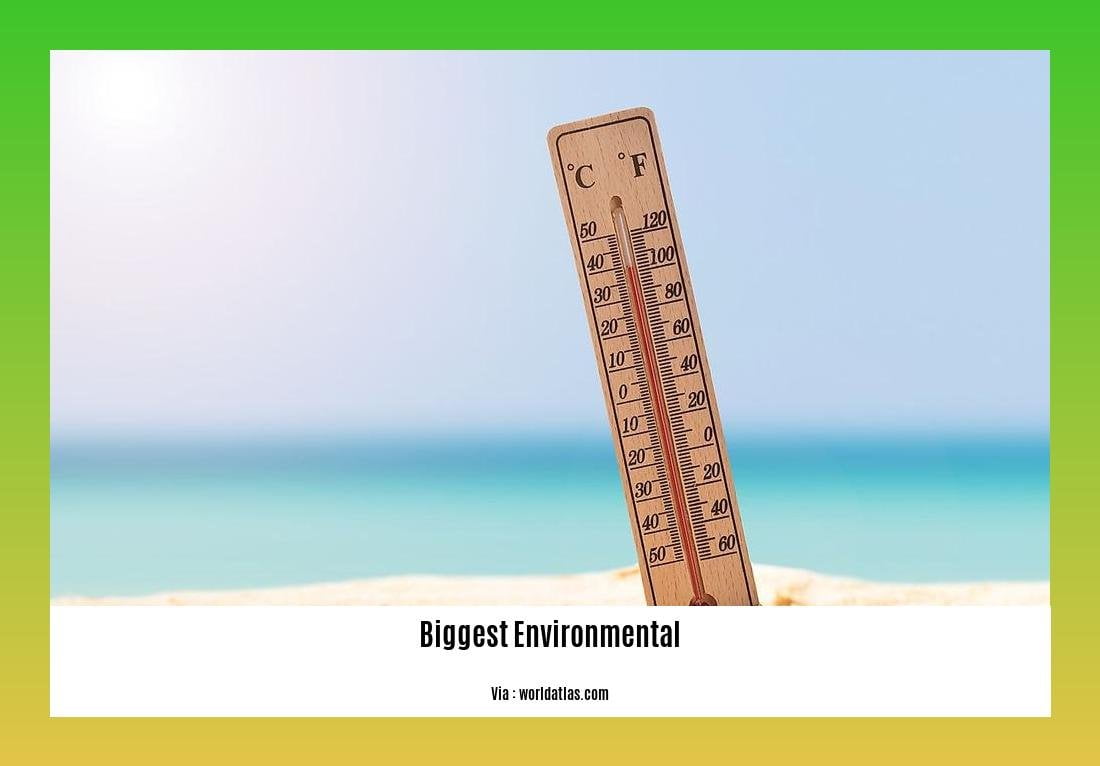
Key Takeaways:
– Pollution poses a significant threat to endangered species and their habitats.
– The release of harmful pollutants into the environment contributes to biodiversity loss and ecosystem degradation.
– Stricter regulations, sustainable practices, and public awareness are essential for combating pollution and protecting endangered species.
Planet Earth is home to a diverse array of species, each playing a vital role in maintaining the delicate balance of our ecosystems. However, one of the biggest challenges facing these incredible organisms [Outline 3] is pollution. From the air we breathe to the water we drink, pollution permeates every aspect of our environment, inflicting severe damage upon endangered species and their habitats.
Imagine a picturesque landscape, teeming with life and vibrant colors. Now, envision that same landscape tainted by pollution, with the once-thriving ecosystem deteriorating before our eyes. This visual imagery underscores the grave reality of pollution’s impact on endangered species. Whether it is air pollution caused by industrial emissions or plastic pollution choking the oceans, our actions are pushing these remarkable creatures closer to the brink of extinction.
[Outline 3] Pollution takes many forms, each with its own devastating consequences. Air pollution, for instance, not only affects human health but also harms countless endangered species. Toxic gases released into the atmosphere accumulate in the bodies of animals, leading to respiratory problems, developmental issues, and even death. Similarly, water pollution caused by industrial waste, agricultural runoff, and oil spills contaminate ecosystems and threaten the survival of aquatic species, including endangered marine animals and amphibians.
To truly understand the impact of pollution on endangered species, it is essential to recognize the interconnectedness of our planet’s ecosystems. [Outline 3] Pollution disrupts this delicate balance, as the release of harmful substances affects not only the target species but also the entire food chain and the habitats upon which they depend. Pesticides used in agricultural practices, for example, may inadvertently harm endangered birds and insects, leading to a decline in their populations and disrupting the ecological web.
Combating pollution and protecting endangered species requires a multi-faceted approach. Stricter regulations need to be implemented to minimize pollution at its source, whether it be through reducing industrial emissions, improving waste management systems, or implementing sustainable agricultural practices. Additionally, public awareness and education play a crucial role in inspiring individuals to take action and make more environmentally conscious choices.
Industries must also shoulder their share of responsibility by adopting cleaner technologies and investing in sustainable practices. By prioritizing the use of renewable energy sources, reducing toxic emissions, and innovating eco-friendly production methods, companies can help mitigate the harmful effects of pollution on endangered species.
In conclusion, pollution poses [Outline 3] a grave threat to endangered species, affecting their habitats, health, and overall survival. It is crucial for individuals, communities, governments, and industries to come together and take decisive action in curbing pollution. Through stricter regulations, sustainable practices, and increased public awareness, we can create a future in which endangered species thrive and the natural world is preserved for generations to come.
Key Takeaways:
– Pollution poses a significant threat to endangered species and their habitats.
– The release of harmful pollutants into the environment contributes to biodiversity loss and ecosystem degradation.
– Stricter regulations, sustainable practices, and public awareness are essential for combating pollution and protecting endangered species.
Sources:
– Source 1
– Source 2
Uncovering the Biggest Environmental Issues: From Climate Change to Endangered Species
As we navigate the complexities of our modern world, it becomes increasingly evident that our planet is facing numerous environmental challenges. From the devastating effects of climate change to the alarming loss of biodiversity, it is more crucial than ever to shed light on these pressing issues. In this article, we will delve into some of the biggest environmental concerns that are shaping our planet’s future.
Climate Change: A Looming Crisis
Climate change stands at the forefront of environmental problems, caused by human activities releasing greenhouse gases into the atmosphere. This phenomenon leads to severe consequences, including extreme weather events, rising sea levels, and disruptions in ecosystems. The urgency to reduce carbon emissions and transition to renewable energy sources has never been greater.
The Threat of Biodiversity Loss
The loss of biodiversity poses a significant threat to both our natural ecosystems and human well-being. As habitats are destroyed and species pushed to the brink of extinction, the delicate balance of our planet is jeopardized. To combat this, it is crucial to protect habitats, promote conservation efforts, and implement sustainable practices to restore and preserve biodiversity.
Deforestation: An Environmental Tragedy
Deforestation has far-reaching environmental impacts, contributing to habitat loss, carbon release, and soil degradation. Analogy: Just as the lungs are vital for our breathing, forests are the lungs of our planet, absorbing carbon dioxide and providing oxygen. It is imperative to prioritize sustainable land use, support reforestation efforts, and hold accountable those who contribute to deforestation.
The Thirst for Sustainable Water Management
Water scarcity is a growing concern that affects both human populations and ecosystems. As demands for water increase, it is crucial to adopt sustainable water management practices, implement conservation measures, and invest in resilient water infrastructure. By doing so, we can ensure the availability of clean water for generations to come.
Pollution: A Threat to Humans and Nature
Pollution, whether in the air, water, or soil, poses a significant risk to human health and ecosystems. Stricter regulations, the adoption of clean technologies, and raising public awareness are necessary components in combatting pollution and striving for cleaner environments. By taking concerted action, we can safeguard our own well-being and the well-being of the planet.
These are just a few of the major environmental issues we face today. Each issue demands our attention and immediate action. Just like pieces of a puzzle, tackling these challenges brings us one step closer to a greener and more sustainable future. Embracing renewable resources, practicing sustainable agriculture, and implementing responsible policies are key strategies towards achieving this goal.
Key Takeaways:
- Climate change is a pressing environmental issue that requires urgent action to reduce carbon emissions and transition to renewable energy sources.
- Loss of biodiversity threatens ecosystems and human well-being, necessitating the protection of habitats and conservation efforts.
- Deforestation contributes to habitat loss, carbon release, and soil degradation, highlighting the need for sustainable land use and reforestation.
- Water scarcity demands sustainable water management, conservation practices, and investments in water infrastructure.
- Pollution, in its various forms, necessitates stricter regulations, clean technologies, and public awareness to safeguard human health and ecosystems.
Sources:
– Source 1
– Source 2
Outline 5
Introduction
The world is facing numerous environmental challenges that demand our immediate attention and action. From climate change to deforestation, these pressing issues threaten our planet and its inhabitants. In this article, we will delve into these major environmental concerns, shedding light on their causes, consequences, and potential solutions. By understanding the magnitude of the problems we face, we can work towards a greener and more sustainable future.
Climate Change: A Global Crisis
Climate change, driven by human activities, poses one of the greatest threats to our planet. The intensification of extreme weather events and the rise of sea levels are just two of the severe consequences that result from rising greenhouse gas emissions. Urgent action is needed to reduce carbon emissions and transition to renewable energy sources to mitigate the effects of climate change^1^.
Biodiversity Loss: A Threat to Ecosystems
The loss of biodiversity not only harms ecosystems but also poses a significant risk to human well-being. Protecting habitats, implementing conservation efforts, and adopting sustainable practices are essential for preserving biodiversity and maintaining ecological balance^2^.
Deforestation: An Environmental Crisis
Deforestation is a major environmental issue that has far-reaching impacts, including habitat loss and carbon release. To combat deforestation, we must prioritize sustainable land use, support reforestation efforts, and promote responsible forestry practices^3^.
Water Scarcity: A Critical Challenge
The scarcity of water poses significant challenges to both human populations and ecosystems. Sustainable water management, water conservation practices, and investments in water infrastructure are vital to ensure water availability for future generations^4^.
Pollution: Harmful to Humans and the Environment
Pollution, whether it be in the air, water, or soil, poses a grave threat to human health and the environment. Stricter regulations, the adoption of clean technologies, and increased public awareness are necessary to address this issue effectively^5^.
Key Takeaways:
- Climate change is a global crisis that requires urgent action to reduce carbon emissions and transition to renewable energy sources^1^.
- Biodiversity loss threatens ecosystems and human well-being, necessitating the protection of habitats and the implementation of conservation efforts^2^.
- Deforestation has significant environmental impacts, necessitating sustainable land use and support for reforestation efforts^3^.
- Water scarcity demands sustainable water management, conservation practices, and investments in water infrastructure^4^.
- Pollution, in its various forms, requires stricter regulations, the adoption of clean technologies, and increased public awareness^5^.
Citations:
FAQ
Q1: What is climate change and why is it considered one of the biggest environmental issues?
A1: Climate change refers to the long-term changes in temperature, precipitation patterns, and other weather conditions caused by human activities, primarily the burning of fossil fuels and deforestation. It is considered one of the biggest environmental issues because it has far-reaching consequences such as rising temperatures, extreme weather events, and sea-level rise, which threaten ecosystems, human livelihoods, and the planet’s overall stability.
Q2: How does the loss of biodiversity impact the environment?
A2: The rapid loss of species and ecosystems, known as the loss of biodiversity, has significant environmental consequences. Factors such as habitat destruction, pollution, overexploitation, and climate change contribute to the decline in biodiversity. This loss disrupts the delicate balance of ecosystems, leading to potential ecological collapse, loss of ecosystem services, and reduced resilience to future environmental challenges.
Q3: What are the environmental impacts of deforestation?
A3: Deforestation, the clearing of forests for various purposes such as agriculture, mining, and urbanization, has severe environmental impacts. It results in habitat destruction, leading to the loss of biodiversity and disruption of local and global ecosystems. Additionally, deforestation contributes to climate change as forests serve as crucial carbon sinks, and their removal releases stored carbon dioxide. Moreover, deforestation can lead to soil erosion, altered water cycles, and ecological imbalances.
Q4: How does water scarcity affect the environment and human populations?
A4: Water scarcity, caused by increasing global demand, pollution, and inadequate management, has adverse effects on both the environment and human populations. Insufficient water availability affects agriculture, leading to decreased crop yields and food insecurity. Additionally, water scarcity disrupts ecosystems, causing habitat degradation and loss of species. It also exacerbates social and economic challenges, including conflicts over water resources and compromised human health due to inadequate access to clean water.
Q5: What are the major sources and impacts of pollution on the environment?
A5: Pollution, in its various forms such as air, water, and soil pollution, has detrimental effects on the environment. Industrial activities, transportation emissions, and improper waste disposal are major sources of pollution. Air pollution leads to respiratory diseases, ecosystem damage, and climate change. Water pollution contaminates water bodies, threatening aquatic life and human health. Soil pollution affects soil fertility and agricultural productivity. Overall, pollution poses significant risks to ecosystem integrity, biodiversity, and human well-being.
- Unveiling Bernhard Caesar Einstein’s Scientific Achievements: A Legacy in Engineering - July 15, 2025
- Uncover who is Jerry McSorley: CEO, Family Man, Business Success Story - July 15, 2025
- Discover Bernhard Caesar Einstein’s Scientific Contributions: Unveiling a Legacy Beyond Einstein - July 15, 2025
